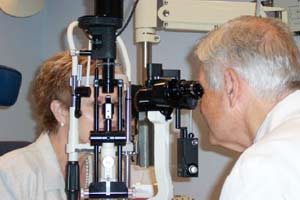Mr. Nga, 60 years old (Ho Chi Minh City), has had diabetes for 15 years. His left eye can only see shadows, and his right eye has a vision of only 3/10. He was unaware that his vision deterioration was due to diabetes. An eye doctor informed him that he is suffering from severe proliferative diabetic retinopathy.
 |
| Regular eye exams help doctors detect stages of diabetes affecting the eyes (Photo: professionaleye) |
Dr. Nguyen Thi My Hanh from the FV Hospital in Ho Chi Minh City stated that many cases are similar to Mr. Nga’s. They have been diabetic for many years but have never undergone regular eye exams. By the time they discover their condition, their eyes are often at a stage of severe asymptomatic proliferative diabetic retinopathy or diabetic retinopathy. If no measures are taken to prevent this stage, they will quickly become blind. For Mr. Nga, there is no chance of recovery for his left eye as there are already tears in the retina. The doctor can only maintain the vision in his right eye using laser treatment.
Diabetes is divided into two groups: one is insulin-dependent (a hormone that stimulates cells to absorb glucose in the blood) which accounts for 10%, commonly seen in younger individuals. Patients in this group exhibit symptoms of excessive eating, frequent urination, and rapid weight loss. The second group is non-insulin-dependent, accounting for 90%, typically seen in individuals over 30 and those who are obese. Patients in this group have fewer symptoms, and the disease progresses silently. The exact cause of this disease has not yet been identified, but its destructive impact on health and the economy is likened to an “economic tsunami.” However, there are recorded genetic factors or familial links for individuals with the disease. In addition, irregular eating habits, sedentary lifestyles, and obesity are also contributing factors to the illness.
| In Vietnam, currently, 65% of approximately 2 million diabetes patients are unaware they have the disease. The number of diabetes cases in urban areas has increased 3-4 times compared to 10 years ago, and in rural areas, the disease is becoming more common. According to forecasts from the World Health Organization, by 2025, there will be over 300 million people with diabetes worldwide. |
In addition to complications such as nerve damage, heart and kidney disease, and vascular accidents, diabetes also has a significant complication that affects health but is often overlooked: eye complications. Diabetes affects small blood vessels, leading to various eye damages, especially in the retina (the nerve layer at the back of the eye) through multiple stages. It begins with very minor injuries such as microaneurysms and hemorrhages, progressing to more severe injuries like bleeding in the eye, leading to traction, retinal detachment, macular damage, and ultimately blindness. Dr. Doric Wong, Head of the Eye Department at the National Eye Centre in Singapore, indicated that diabetes is one of the leading causes of blindness in developed countries today.
However, “if eye injuries are detected early, laser treatment can be used to prevent the disease from progressing further and maintain the patient’s current vision. But once the injury has reached a severe stage, treatments will be ineffective, and the disease will continue to progress without prevention,” Dr. Hanh warned.
In addition to diabetes, high blood pressure is also a significant threat to everyone’s health. Besides being a leading cause of disability and death among older adults, high blood pressure can also damage small blood vessels in the retina and cause similar eye complications as those caused by diabetes. Initial injuries can also be effectively treated.
Therefore, regular eye examinations are essential for patients with diabetes and hypertension, even if they do not notice any unusual symptoms in their eyes. Regular eye exams not only help detect complications early to maintain timely vision care but also allow doctors to identify stages of diabetes affecting the eyes and monitor the level of hypertension in patients, leading to appropriate treatment and follow-up.
My Lan


















































